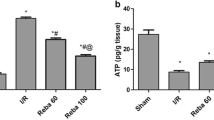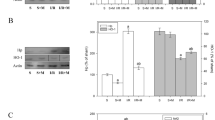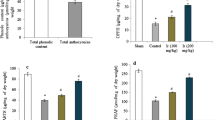Abstract
Hepatic ischemia-reperfusion (I/R) injury may be developed in some conditions, such as trauma, major hepatic resection, hemorrhagic shock or liver transplantation. I/R injury of the liver causes hepatocellular damage that may lead to hepatic failure. A considerable body of evidence indicates that reactive oxygen species (ROS) and inflammation may contribute to hepatocellular injury in liver I/R. Leflunomide is an isoxazole derivative, and a unique immunomodulatory agent. In the present study, we examined the effects of leflunomide on the neutrophil activation with oxidative stress and some antioxidant enzymes in the reperfusion following I/R in the rat liver. Thirty-two rats divided into four groups: group 1 (control); was given leflunomide 10 mg/kg, i.g.; group 2 (SHAM), animals were only laparotomized; group 3 (liver I/R), and group 4 (liver I/R + Leflunomide). In group 4, rats were pretreated with leflunomide (10 mg/kg, i.g.) two doses prior to experiment. In groups 3 and 4, occluding the hepatic pedicel for 60 min induced ischemia and reperfusion was allowed thereafter for 60 min. At the end of the reperfusion period, rats were sacrificed. superoxide dismutase, catalase, nitric oxide, xanthine oxidase, malondialdehyde, protein carbonyl and myeloperoxidase levels were determined in hepatic tissue as well as histological examination with H and E staining. Group 3 animals demonstrated severe deterioration of liver morphology and a significant liver oxidative stress. Pretreatment of animals with leflunomide markedly attenuated morphological alterations and neutrophil activation, reduced elevated oxidative stress products levels and restored the depleted hepatic antioxidant enzyme. The findings imply that ROS play a causal role in I/R-induced hepatic injury, and leflunomide exerts hepatoprotective effects probably by the anti-inflammatory effect with radical scavenging and antioxidant activities.



Similar content being viewed by others
References
Allan T, Takashi K, Atsunori N, Lifang S et al (2005) Ethyl pyruvate ameliorates liver ischemia-reperfusion injury by decreasing hepatic necrosis and apoptosis. Transplantation 79:196–204
De Tata V, Brizi S, Saviozzi M, Lazzarotti A et al (2005) Protective role of dehydroascorbate in rat liver ischemia-reperfusion injury. J Surg Res 123:215–221
Liu DL, Jeppsson B, Hakansson CH et al (1996) Multiplesystem organ damage resulting from prolonged hepatic inflow interruption. Arch Surg 131:442
Lemasters JJ, Thurman RG (1997) Reperfusion injury after liver preservation for transplantation. Annu Rev Pharmacol Toxicol 37:327–338
Olthoff KM (2001) Can reperfusion injury of the liver be prevented? Trying to improve on a good thing. Pediatr Transplant 5:390–393
Man K, Ng KT, Lee TK, Lo Cm et al (2005) FTY720 attenuates hepatic ischemia-reperfusion injury in normal and cirrhotic livers. Am J Transplant 5:40–49
Jaeschke H (2000) Reactive oxygen and mechanisms of inflammatory liver injury. J Gastroenterol Hepatol 15:718–724
Fondevila C, Shen X, Tsuchiyashi S, Yamashita K et al (2004) Biliverdin therapy protects rat livers from ischemia and reperfusion injury. Hepatology 40:1333–1341
McCord JM (1985) Oxygen-derived free radicals in postischemic tissue injury. N Engl Med 312:159–163
Farber JL, Kyle ME, Coleman JB (1990) Mechanisms of cell injury by activated oxygen species. Lab Invest 62:670–679
Hensley K, Robinson KA, Gabbita SP, Salsman S, Floyd RA (2000) Reactive oxygen species, cell signaling, and cell injury. Free Radic Biol Med 28:1456–1462
Kurokawa T, Nonami T, Harada A, Nakao A, Takagi H (1996) Mechanism and prevention of ischemia-reperfusion injury of the liver. Semin Surg Oncol 12:179–182
Sanders S, Harisdangkul V. (2002) Leflunomide for the treatment of rheumatoid arthritis and autoimmunity. Am J Med Sci 323:190–193
Osiri M, Shea B, Robinson V, Suarez-Almazor M et al (2003) Leflunomide for the treatment of rheumatoid arthritis: a systematic review and metaanalysis. J Rheumatol 30:1182–1190
Williams JW, Mital D, Chong A, Kottayil A et al (2002) Experiences with leflunomide in solid organ transplantation. Transplantation 73:358–366
Kessel A, Toubi E (2002) Leflunomide in systemic lupus erythematosus. Harefuah 141:355–357
Prajapati DN, Knox JF, Emmons J, Saeian K et al (2003) Leflunomide treatment of Crohn’s disease patients intolerant to standard immunomodulator therapy. J Clin Gastroenterol 37:125–128
Breedveld FC, Dayer JM (2000) Leflunomide: mode of action in the treatment of rheumatoid arthritis. Ann Rheum Dis 59:841–849
Herrmann ML, Schleyerbach R, Kirschbaum BJ (2000) Leflunomide: an immunomodulatory drug for the treatment of rheumatoid arthritis and other autoimmune diseases. Immunopharmacology 47:273–289
Li WD, Ran GX, Teng HL, Lin ZB (2002) Dynamic effects of leflunomide on IL-1, IL-6, and TNF-an activity produced from peritoneal macrophages in adjuvant arthritis rats. Acta Pharmacol Sin 23:752–756
Bartlett RR, Anagnostopulos H, Zıelınskı T, Mattar T, Schleyerbach R (1993) Effects of lefunomide on immune responses and models of inflammation. Springer Semin Immunopathol 14:381–394
Irmak MK, Koltuksuz U, Kutlu NO et al (2001) The effect of caffeic acid phenethyl ester on ischemia-reperfusion injury in comparison with alpha-tocopherol in rat kidneys. Urol Res 29:190–193
Lowry O, Rosenbraugh N, Farr L, Rondall R (1951) Protein measurement with the folin-phenol reagent. J Biol Chem 183:265–275
Aebi H (1974) Catalase. In: Bergmeyer HU (eds) Methods of enzymatic analysis. Academic, New York, pp 673–677
Sun Y, Oberley LW, Li Y (1988) A simple method for clinical assay of superoxide dismutase. Clin Chem 34:497–500
Prajda N, Weber G (1975) Malign transformation-linked imbalance: decreased XO activity in hepatomas. FEBS Lett 59:245–249
Cortas NK, Wakid NW (1990) Determination of inorganic nitrate in serum and urine by a kinetic cadmium-reduction method. Clin Chem 36:1440–1443
Esterbauer H, Cheeseman KH (1990) Determination of aldehydic lipid peroxidation products: Malonaldehyde and 4-hydroxynonenal. In: Packer L, Glazer AN (eds) Methods in enzymology, vol 186. Oxygen radicals in biological systems. Academic, New York, pp 407–421
Levine RL, Garland D, Oliver CN, Amici A et al (1990) Determination of carbonyl content in oxidatively modified proteins. In: Packer L, Glazer AN (eds) Methods in enzymology, vol 186. Oxygen radicals in biological systems. Academic, New York, pp 464–478
Wei H, Frenkel K (1993) Relationship of oxidative events and DNA oxidation in SENCAR mice to in vivo promoting activity of phorbol ester-type tumor promoters. Carcinogenesis 14:1195–1201
Suzuki S, Toledo-Pereyra LH, Rodriguez FJ, Cejalvo D (1993) Neutrophil infiltration as an important factor in liver ischemia and reperfusion injury. Modulating effects of FK506 and cyclosporine. Transplantation 55:1265–1272
Aydemir EO, Var A, Uyanik BS, Ilkgul Ö et al (2003) The protective mechanisms of defibrotide on liver ischaemia-reperfusion injury. Cell Biochem Funct 21:307–310
Galley HF, Richardson N, Howdle PD,Walker BE,Webster NR (1995) Total antioxidant capacity and lipid peroxidation during liver transplantation. Clin Sci 89:329–332
Goode HF, Webster NR, Howdle PD, Leek JP, Lodge JP (1994) Reperfusion injury, antioxidants and hemodynamics during orthotopic liver transplantation. Hepatology 19:354–359
Arii S, Teramoto K, Kawamura T (2003) Current progress in the understanding of and therapeutic strategies for ischemia and reperfusion injury of the liver. J Hepatobiliary Pancreat Surg 10:189–194
McCord JM (1985) Oxygen-derived free radicals in postischemic tissue injury. N Engl J Med 312:159–163
Adkins D, Hollwarth ME, Benoit JN, Parks DA et al (1986) Role of free radicals in ischemia-reperfusion injury to the liver. Acta Physiol Scand Suppl 548:101–107
Tomizawa N, Ohwada S, Ohya T, Kawashima Y et al (1999) The effect of neutrophil elastase inhibitor in hepatectomy with ischemia in dogs. J Surg Res 81:230–237
Shen YC, Chen CF, Sung YJ (1999) Tetrandrine ameliorates ischaemiareperfusion injury of rat myocardium through inhibition of neutrophil priming and activation. Br J Pharmacol 128:1593–1601
Hansen PR (1995) Role of neutrophils in myocardial ischemia and reperfusion. Circulation 91:1872–1885
Manna SK, Aggarwal BB (1999) Immunosuppressive leflunomide metabolite (A77 1726) blocks TNF-dependent nuclear factor-kB activation and gene expression. J Immunol 162:2095–2102
Manna SK, Mukhopadhyay A, Aggarwal BB (2000) Leflunomide suppresses TNF-induced cellular responses: effects on NF-kB, activator protein-1, c-Jun N-terminal protein kinase, and apoptosis. J Immunol 165:5962–5969
Krawisz JE, Sharon P, Stenson WF (1984) Quantitative assay for acute intestinal inflammation based on myeloperoxidase activity. Gastroenterology 87:1334–1350
Liu Z, Xu Z, Shen W, Li Y et al (2004) Effect of pharmacologic preconditioning with tetrandrine on subsequent ischemia/reperfusion injury in rat liver. World J Surg 28:620–624
Slater TF (1984) Free-radical mechanisms in tissue injury. Biochem J 222:1
Taha MO, Carvalho CA, Souza HS, Fagundes DJ (2004) Cytoprotective effects of alpha-tocopherol on ischemia/reperfusion injury in rat liver: biochemical and histological evaluation. Transplant Proc 36:276–282
Busse R, Mulsch A (1990) Calcium-dependent nitric oxide synthesis in endothelial cells is mediated by nitric oxide: a cytotoxic activated macrophage effector molecule. FEBS Lett 265:133–136
Gaboury J, Woodman R, Granger D, Reinhardt P, Kubes P (1993) Nitric oxide prevents leukocyte adherence: a role of superoxide. Am J Physiol 265:862–867
Zweir JL, Wang P, Samouilov A, Kuppusamy P (1995) Enzyme-independent formation of nitric-oxide in biological tissues. Nat Med 1:804–809
Beckman JS, Beckman TW, Chen J, Marshall PA, Freeman BA (1990) Apparent hydroxyl radical production by peroxynitrite: implications for endothelial injury from nitric oxide and superoxide. Proc Natl Acad Sci USA 87:1620–1624
Demir S, Inal-Erden M (1998) Pentoxifylline and N-acetylcysteine in hepatic ischemia/reperfusion injury. Clin Chim Acta 275:127–135
Elkayam O, Yaron I, Shirazi I et al (2003) Active leflunomide metabolite inhibits interleukin 1b, tumour necrosis factor a, nitric oxide, and metalloproteinase-3 production in activated human synovial tissue cultures. Ann Rheum Dis 62:440–443
Reddy SVB, Wanchu A, Khullar M et al (2005) Leflunomide reduces nitric oxide production in patients with active rheumatoid arthritis. Int Immunopharmacol 5:1085–1090
Yao HW, Li J, Jin Y et al (2003) Effect of leflunomide on immunological liver injury in mice. World J Gastroenterol 9:320–923
Yao HW, Li J, Chen JO, Xu SU (2004) Inhibitory effect of leflunomide on hepatic fibrosis induced by CCl4 in rats. Acta Pharmacol Sin 25:915–920
Author information
Authors and Affiliations
Corresponding author
Rights and permissions
About this article
Cite this article
Karaman, A., Fadillioglu, E., Turkmen, E. et al. Protective effects of leflunomide against ischemia-reperfusion injury of the rat liver. Ped Surgery Int 22, 428–434 (2006). https://doi.org/10.1007/s00383-006-1668-x
Accepted:
Published:
Issue Date:
DOI: https://doi.org/10.1007/s00383-006-1668-x




